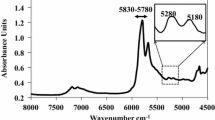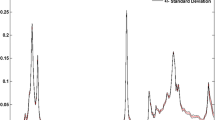Abstract
Environmental contamination caused by leakage of fuels and lubricant oils at gas stations is of great concern due to the presence of carcinogenic compounds in the composition of gasoline, diesel, and mineral lubricant oils. Chromatographic methods or non-selective infrared methods are usually used to assess soil contamination, which makes environmental monitoring costly or not appropriate. In this perspective, the present work proposes a methodology to identify the type of contaminant (gasoline, diesel, or lubricant oil) and, subsequently, to quantify the contaminant concentration using attenuated total reflection Fourier transform infrared (ATR-FTIR) spectroscopy and multivariate methods. Firstly, gasoline, diesel, and lubricating oil samples were acquired from gas stations and analyzed by gas chromatography to determine the total petroleum hydrocarbon (TPH) fractions (gasoline range organics, diesel range organics, and oil range organics). Then, solutions of these contaminants in hexane were prepared in the concentration range of about 5–10,000 mg kg−1. The infrared spectra of the solutions were obtained and used for the development of the pattern recognition model and the calibration models. The partial least square discriminant analysis (PLS-DA) model could correctly classify 100% of the samples of each type of contaminant and presented selectivity equal to 1.00, which provides a suitable method for the identification of the source of contamination. The PLS regression models were developed using multivariate filters, such as orthogonal signal correction (OSC) and general least square weighting (GLSW), and selection variable by genetic algorithm (GA). The validation of the models resulted in correlation coefficients above 0.96 and root-mean-square error of prediction values below the maximum permissible contamination limit (1000 mg kg−1). The methodology was validated through the addition of fuels and lubricating oil in soil samples and quantification of the TPH fractions through the developed models after the extraction of the analytes by the EPA 3550 method adapted by the authors. The recovery percentage of the analytes was within the acceptance limits of ASTM D7678 (70–130%), except for one sample (69% of recovery). Therefore, the methodology proposed here provides faster and less costly analyses than the chromatographic methods and it is adequate for the environmental monitoring of soil contamination by gas stations.




Similar content being viewed by others
References
AMERICAN SOCIETY FOR TESTING AND MATERIALS. (2011). ASTM D7678—standard test method for total petroleum hydrocarbons (TPH) in water and wastewater with solvent extraction using mid-IR laser. Transportation, (C), 1–9. https://doi.org/10.1520/D7678
AMERICAN SOCIETY FOR TESTING AND MATERIALS. (2012). ASTM E1655—standard practices for infrared multivariate quantitative analysis. ASTM International, 5(Reapproved 2012), 29. https://doi.org/10.1520/E1655-05R12.2
AMERICAN SOCIETY FOR TESTING AND MATERIALS. (2013). ASTMD 6209—standard test method for determination of gaseous and particulate polycyclic aromatic hydrocarbons in ambient air (collection on sorbent-backed filters with gas chromatographic/mass spectrometric analysis), 1–14. https://doi.org/10.1520/D6209-13.2.
AMERICAN SOCIETY FOR TESTING AND MATERIALS. (2015). ASTM D5769. Standard test method for determination of benzene, toluene, and total aromatics in finished gasolines by gas chromatography/mass spectrometry., 5(October), 1–7. https://doi.org/10.1128/AEM.68.6.2660
Ballabio, D., & Consonni, V. (2013). Classification tools in chemistry. Part 1: Linear models. PLS-DA. Analytical Methods, 5(16), 3790. https://doi.org/10.1039/c3ay40582f.
Bosch-Reig, F., Gimeno-Adelantado, J. V., Bosch-Mossi, F., & Domnech-Carb, A. (2017). Quantification of minerals from ATR-FTIR spectra with spectral interferences using the MRC method. Spectrochimica Acta-Part A: Molecular and Biomolecular Spectroscopy, 181, 7–12. https://doi.org/10.1016/j.saa.2017.02.012.
BP. (2016). Statistical review of world energy. BP Statistical Review of World Energy, 65ª ed (p. 48). London. https://www.bp.com/content/dam/bp/pdf/energy-economics/statistical-review-2016/bp-statistical-review-of-world-energy-2016-full-report.pdf.
Brereton, R. G., & Lloyd, G. R. (2014). Partial least squares discriminant analysis: taking the magic away. Journal of Chemometrics, 28(4), 213–225. https://doi.org/10.1002/cem.2609.
Burns, D. A., & Ciurczak, E. W. (2009). Handbook of near-infrared analysis, 3rd ed. Analytical and Bioanalytical Chemistry., 124(19), 5603–5604. https://doi.org/10.1021/ja015320c.
COMPANHIA AMBIENTAL DO ESTADO DE SÃO PAULO. (2016a). Texto explicativo: relação de áreas contaminadas e reabilitadas no Estado de São Paulo. Cetesb. http://cetesb.sp.gov.br/areas-contaminadas/wp-content/uploads/sites/17/2013/11/Texto-explicativo-2016.pdf.
COMPANHIA AMBIENTAL DO ESTADO DE SÃO PAULO. (2016b). SISTEMA DE LICENCIAMENTO DE POSTOS IV - Procedimento para Identificação de Passivos Ambientais em Estabelecimentos com Sistema de Armazenamento Subterrâneo de Combustíveis (SASC).
Da Silva, M. P. F., Brito, L. R. E., Honorato, F. A., Paim, A. P. S., Pasquini, C., & Pimentel, M. F. (2014). Classification of gasoline as with or without dispersant and detergent additives using infrared spectroscopy and multivariate classification. Fuel, 116, 151–157. https://doi.org/10.1016/j.fuel.2013.07.110.
Eigenvector Research. (2013). Advanced preprocessing: multivariate filtering. http://wiki.eigenvector.com/index.php?title=Advanced_Preprocessing:_Multivariate_Filtering
Forrester, S., Janik, L., & Mclaughlin, M. (2010). An infrared spectroscopic test for total petroleum hydrocarbon (TPH) contamination in soils. Proc. 19th World Congress of Soil Science, 1–6 August 2010, Brisbane, Australia, (August), 13–16.
Forrester, S. T., Janik, L. J., McLaughlin, M. J., Soriano-Disla, J. M., Stewart, R., & Dearman, B. (2013). Total petroleum hydrocarbon concentration prediction in soils using diffuse reflectance infrared spectroscopy. Soil Science Society of America Journal, 77(2), 450. https://doi.org/10.2136/sssaj2012.0201.
Gemperline, P. (2006). Practical guide to chemometrics, Second Edition. Book (Chemo). https://doi.org/10.1201/9781420018301.
Hawkins, D. M. (2004). The problem of overfitting. Journal of Chemical Information and Computer Sciences, 44(1), 1–12. https://doi.org/10.1021/ci0342472.
Horta, A., Malone, B., Stockmann, U., Minasny, B., Bishop, T. F. A., McBratney, A. B., Pallasser, R., & Pozza, L. (2015). Potential of integrated field spectroscopy and spatial analysis for enhanced assessment of soil contamination: a prospective review. Geoderma, 241–242, 180–209. https://doi.org/10.1016/j.geoderma.2014.11.024.
Laghi, L., Versari, A., Parpinello, G. P., Nakaji, D. Y., & Boulton, R. B. (2011). FTIR spectroscopy and direct orthogonal signal correction preprocessing applied to selected phenolic compounds in red wines. Food Analytical Methods, 4(4), 619–625. https://doi.org/10.1007/s12161-011-9240-2.
Mehmood, T., Liland, K. H., Snipen, L., & Sæbø, S. (2012). A review of variable selection methods in partial least squares regression. Chemometrics and Intelligent Laboratory Systems, 118, 62–69. https://doi.org/10.1016/j.chemolab.2012.07.010.
Nespeca, M. G., Rodrigues, C. V., Santana, K. O., Maintinguer, S. I., & de Oliveira, J. E. (2017). Determination of alcohols and volatile organic acids in anaerobic bioreactors for H 2 production by near infrared spectroscopy. International Journal of Hydrogen Energy, 42(32), 20480–20493. https://doi.org/10.1016/j.ijhydene.2017.07.044.
Okparanma, R. N., & Mouazen, A. M. (2013). Determination of total petroleum hydrocarbon (TPH) and polycyclic aromatic hydrocarbon (PAH) in soils: a review of spectroscopic and nonspectroscopic techniques. Applied Spectroscopy Reviews, 48(6), 458–486. https://doi.org/10.1080/05704928.2012.736048.
Pejcic, B., Boyd, L., Myers, M., Ross, A., Raichlin, Y., Katzir, A., Lu, R., & Mizaikoff, B. (2013). Direct quantification of aromatic hydrocarbons in geochemical fluids with a mid-infrared attenuated total reflection sensor. Organic Geochemistry, 55, 63–71. https://doi.org/10.1016/j.orggeochem.2012.11.011.
Rajalahti, T., Arneberg, R., Berven, F. S., Myhr, K. M., Ulvik, R. J., & Kvalheim, O. M. (2009). Biomarker discovery in mass spectral profiles by means of selectivity ratio plot. Chemometrics and Intelligent Laboratory Systems, 95(1), 35–48. https://doi.org/10.1016/j.chemolab.2008.08.004.
Rocha, W. F. C., Vaz, B. G., Sarmanho, G. F., Leal, L. H. C., Nogueira, R., Silva, V. F., & Borges, C. N. (2012). Chemometric techniques applied for classification and quantification of binary biodiesel/diesel blends. Analytical Letters, 45(16), 2398–2411. https://doi.org/10.1080/00032719.2012.686135.
Roudier, P., Hedley, C. B., Lobsey, C. R., Viscarra Rossel, R. A., & Leroux, C. (2017). Evaluation of two methods to eliminate the effect of water from soil vis–NIR spectra for predictions of organic carbon. Geoderma, 296, 98–107. https://doi.org/10.1016/j.geoderma.2017.02.014.
Schwartz, G., Ben-Dor, E., & Eshel, G. (2012). Quantitative analysis of total petroleum hydrocarbons in soils: comparison between reflectance spectroscopy and solvent extraction by 3 certified laboratories. Applied and Environmental Soil Science, 2012, 1–11. https://doi.org/10.1155/2012/751956.
Silverstein, M. R., Webster, F. X., & Kiemle, D. J. (2005). Spectrometric identification of organic compounds-7th Ed. State University of New York.
Todd, G. D., Chessin, R. L., & Colman, J. (1999). Toxicological profile for total petroleum hydrocarbons (TPH). Agency for Toxic Substances and Disease Registry. Atlanta: Agency for Toxic Substances and Disease Registry.
US ENVIRONMENTAL PROTECTION AGENCY. (1978). Method 418.1: petroleum hydrocarbons (spectrophotometric, infrared).
US ENVIRONMENTAL PROTECTION AGENCY. (1996a). Method 8440—total recoverable petroleum hydrocarbons by infrared spectrophotometry. Washington DC: EPA Methods.
US ENVIRONMENTAL PROTECTION AGENCY. (1996b). Method 3510C: separatory funnel liquid-liquid extraction. Test Methods for Evaluating Solid Waste, Physical/Chemical Methods, (December), 1–8.
US ENVIRONMENTAL PROTECTION AGENCY. (1996c). Method 3540C: Soxhlet extraction. Washington DC: US Environmental Protection Agency. https://doi.org/10.1017/CBO9781107415324.004.
US ENVIRONMENTAL PROTECTION AGENCY. (2007a). Method 8015C: nonhalogenated organics by gas chromatography. Washington DC.
US ENVIRONMENTAL PROTECTION AGENCY. (2007b). Method 3550: ultrasonic extraction. Washington DC: EPA Methods.
US ENVIRONMENTAL PROTECTION AGENCY. (2010). Method 1664: n-hexane extractable material (HEM; oil and grease) and silica gel treated n-hexane extractable material (SGT-HEM; non-polar material) by extraction and gravimetry. Washington DC.
Vershinin, V. I., & Petrov, S. V. (2016). The estimation of total petroleum hydrocarbons content in waste water by IR spectrometry with multivariate calibrations. Talanta, 148, 163–169. https://doi.org/10.1016/j.talanta.2015.10.076.
Vohland, M., Ludwig, M., Thiele-Bruhn, S., & Ludwig, B. (2014). Determination of soil properties with visible to near- and mid-infrared spectroscopy: effects of spectral variable selection. Geoderma, 223–225(1), 88–96. https://doi.org/10.1016/j.geoderma.2014.01.013.
Wang, L., Liu, E., Cheng, Y., Bekele, D. N., Lamb, D., Chen, Z., Megharaj, M., & Naidu, R. (2015). Novel methodologies for automatically and simultaneously determining BTEX components using FTIR spectra. Talanta, 144, 1104–1110. https://doi.org/10.1016/j.talanta.2015.07.044.
Wang, Y., Rong, Z., Qin, Y., Peng, J., Li, M., Lei, J., et al. (2016). The impact of fuel compositions on the particulate emissions of direct injection gasoline engine. Fuel, 166, 543–552. https://doi.org/10.1016/j.fuel.2015.11.019.
Webster, G. T., Soriano-Disla, J. M., Kirk, J., Janik, L. J., Forrester, S. T., McLaughlin, M. J., & Stewart, R. J. (2016). Rapid prediction of total petroleum hydrocarbons in soil using a hand-held mid-infrared field instrument. Talanta, 160, 410–416. https://doi.org/10.1016/j.talanta.2016.07.044.
Weisman, W. H. (1998). Analysis of petroleum hydrocarbons in environmental media. (W. Weisman, Ed.)Total Petroleum Hydrocarbon Criteria Working Group Series (Vol. 1). Amherst: Total Petroleum Hydrocarbon Criteria Working Group Series. http://www.qros.co.uk/Total Petroleum Hydrocarbon Criteria Working Group Series Volume 1 Analysis of petroleum hydrocarbons in environmental media.pdf
Wold, S., Antti, H., Lindgren, F., & Öhman, J. (1998). Orthogonal signal correction of near-infrared spectra. Chemometrics and Intelligent Laboratory Systems, 44(1–2), 175–185. https://doi.org/10.1016/S0169-7439(98)00109-9.
Workman, J., & Weyer, L. (2007). Practical guide to interpretive near-infrared spectroscopy. CRC Press., 47(25), 4628–4629. https://doi.org/10.1002/anie.200885575.
Worley, B., Halouska, S., & Powers, R. (2013). Utilities for quantifying separation in PCA/PLS-DA scores plots. Analytical Biochemistry, 433(2), 102–104. https://doi.org/10.1016/j.ab.2012.10.011.
Xiaobo, Z., Jiewen, Z., Povey, M. J. W., Holmes, M., & Hanpin, M. (2010). Variables selection methods in near-infrared spectroscopy. Analytica Chimica Acta, 667(1–2), 14–32. https://doi.org/10.1016/j.aca.2010.03.048.
Yin, M., Tang, S., & Tong, M. (2016). Identification of edible oils using terahertz spectroscopy combined with genetic algorithm and partial least squares discriminant analysis. Analytical Methods, 8(13), 2794–2798. https://doi.org/10.1039/C6AY00259E.
Zhang, M. L., Sheng, G. P., Mu, Y., Li, W. H., Yu, H. Q., Harada, H., & Li, Y. Y. (2009). Rapid and accurate determination of VFAs and ethanol in the effluent of an anaerobic H2-producing bioreactor using near-infrared spectroscopy. Water Research, 43(7), 1823–1830. https://doi.org/10.1016/j.watres.2009.01.018.
Acknowledgements
The authors would like to thank Cempeqc for providing samples and equipment for analyses.
Funding
The authors would like to thank Capes for providing academic scholarship.
Author information
Authors and Affiliations
Corresponding author
Rights and permissions
About this article
Cite this article
Nespeca, M.G., Piassalonga, G.B. & de Oliveira, J.E. Infrared spectroscopy and multivariate methods as a tool for identification and quantification of fuels and lubricant oils in soil. Environ Monit Assess 190, 72 (2018). https://doi.org/10.1007/s10661-017-6454-9
Received:
Accepted:
Published:
DOI: https://doi.org/10.1007/s10661-017-6454-9




